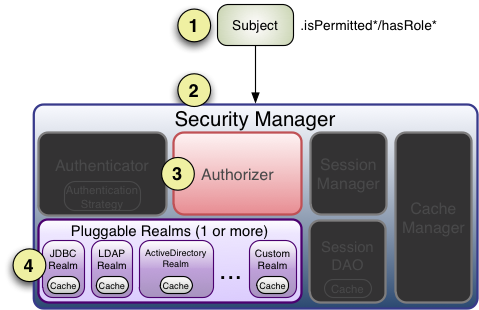ホームページ >バックエンド開発 >PHPチュートリアル >Apache Kiri ユーザーマニュアル (3) Shir 認可
認可はアクセス制御であり、ユーザーがアプリケーション内のリソースへの対応するアクセス権を持っているかどうかを決定します。
たとえば、ユーザーがページを表示する権限、データを編集する権限、特定のボタンを持つ権限、印刷する権限などを持っているかどうかを判断します。
1. 認可の 3 つの要素
認可には、権限、ロール、ユーザーという 3 つの主要な要素があります。
アクセス許可
アクセス許可は、Apache Tora セキュリティ メカニズムの中核要素です。アプリケーションで許可される動作とパフォーマンスを明確に示します。適切にフォーマットされた権限ステートメントは、ユーザーがリソースに対して持つ権限を明確に伝えます。
ほとんどのリソースは一般的な CRUD 操作 (作成、読み取り、更新、削除) をサポートしますが、どの操作も特定のリソースに基づくことが理にかなっています。したがって、許可宣言の基本的な考え方はリソースと操作に基づいています。
そして、許可の宣言を通じて、この許可がアプリケーションで何ができるかを理解することしかできませんが、誰がこの許可を持っているかを判断することはできません。
そのため、アプリケーションでユーザーと権限を関連付ける必要があります。
通常のアプローチは、ロールに権限を割り当て、このロールを 1 人以上のユーザーに関連付けることです。
パーミッション宣言と粒度
Shiroパーミッション宣言は通常、コロンで区切られた式を使用します。前述したように、アクセス許可式では、リソース タイプ、許可される操作、およびアクセス可能なデータを明確に指定できます。同時に、Shiro 権限表現は単純なワイルドカードをサポートしており、より柔軟な権限設定が可能です。
以下では、例を使用して許可の式を説明します。
ユーザーデータのクエリが可能
User:view
ユーザーデータのクエリまたは編集が可能
User:view,edit
ユーザーデータに対するすべての操作の実行が可能
User:* またはユーザー
は 123 の ID を編集可能ユーザーデータ
User:edit:123
ロール
Shiro は 2 つのロール モードをサポートしています:
1. 従来のロール: ロールは、操作の承認検証が必要な場合に、それが承認されているかどうかを判断するだけです。役割。この種のロール権限は比較的単純かつ曖昧であるため、拡張にはつながりません。
2. 権限ロール: ロールには一連の権限があります。権限の検証中に、現在のロールに権限があるかどうかを判断する必要があります。この種類のロール権限は、ロールの詳細な権限の説明を提供することができ、より複雑な権限の設計に適しています。
2 つの役割モードの認可の実装については、以下で詳しく説明します。
2. 認可実装
Shiro は認可プロセスを実装する 3 つの方法をサポートしています:
コーディング実装
アノテーション実装
JSP Taglig 実装
1. コーディングに基づく認可実装
1.1 従来のロールに基づく認可実装
検証が必要です ユーザーが特定のロールを持っている場合、Subject インスタンスの hasRole* メソッドを呼び出して検証できます。
Subject currentUser = SecurityUtils.getSubject();
if (currentUser.hasRole("administrator")) {
//show the admin button
} else {
//don't show the button? Grey it out?
}関連する検証方法は以下のとおりです:
対象方法gt; リスト配列の順序で対応するブール値を返します
;hasAllRoles(Collection
アサーションのサポート
Shiro はアサーションの形式での承認検証もサポートしています。アサーションが成功した場合、値は返されず、プログラムは実行を続行します。アサーションが失敗した場合、例外メッセージがスローされます。アサーションを使用すると、コードをより簡潔にすることができます。
Subject currentUser = SecurityUtils.getSubject();
//guarantee that the current user is a bank teller and
//therefore allowed to open the account:
currentUser.checkRole("bankTeller");
openBankAccount(); の 関連メソッド:
Subject メソッド 説明
org.apache.hiro.authz.Permission のインスタンスを作成し、そのインスタンス オブジェクトを認証用のパラメータとして Subject.isPermitted() に渡します。 。
Permission printPermission = new PrinterPermission("laserjet4400n", "print");
Subject currentUser = SecurityUtils.getSubject();
if (currentUser.isPermitted(printPermission)) {
//show the Print button
} else {
//don't show the button? Grey it out?
}
Permission printPermission = new PrinterPermission("laserjet4400n", "print");
Subject currentUser = SecurityUtils.getSubject();
if (currentUser.isPermitted(printPermission)) {
//show the Print button
} else {
//don't show the button? Grey it out?
}isPermitted(List
isPermittedAll(Collection
2、 基于字符串的实现
相比笨重的基于对象的实现方式,基于字符串的实现便显得更加简洁。
Subject currentUser = SecurityUtils.getSubject();
if (currentUser.isPermitted("printer:print:laserjet4400n")) {
//show the Print button
} else {
//don't show the button? Grey it out?
}使用冒号分隔的权限表达式是org.apache.shiro.authz.permission.WildcardPermission 默认支持的实现方式。
这里分别代表了 资源类型:操作:资源ID
类似基于对象的实现相关方法,基于字符串的实现相关方法:
isPermitted(String perm)、isPermitted(String... perms)、isPermittedAll(String... perms)
基于权限对象的断言实现
Subject currentUser = SecurityUtils.getSubject();
//guarantee that the current user is permitted
//to open a bank account:
Permission p = new AccountPermission("open");
currentUser.checkPermission(p);
openBankAccount();基于字符串的断言实现
Subject currentUser = SecurityUtils.getSubject();
//guarantee that the current user is permitted
//to open a bank account:
currentUser.checkPermission("account:open");
openBankAccount();断言实现的相关方法
Subject方法 说明
checkPermission(Permission p) 断言用户是否拥有制定权限
checkPermission(String perm) 断言用户是否拥有制定权限
checkPermissions(Collection
checkPermissions(String... perms) 断言用户是否拥有所有指定权限
2、基于注解的授权实现
Shiro注解支持AspectJ、Spring、Google-Guice等,可根据应用进行不同的配置。
相关的注解:
@ RequiresAuthentication
可以用户类/属性/方法,用于表明当前用户需是经过认证的用户。
@RequiresAuthentication
public void updateAccount(Account userAccount) {
//this method will only be invoked by a
//Subject that is guaranteed authenticated
...
}
@ RequiresGuest表明该用户需为”guest”用户
@ RequiresPermissions
当前用户需拥有制定权限
@RequiresPermissions("account:create")
public void createAccount(Account account) {
//this method will only be invoked by a Subject
//that is permitted to create an account
...
}
@RequiresRoles当前用户需拥有制定角色
@ RequiresUser
当前用户需为已认证用户或已记住用户
3、基于JSP TAG的授权实现
Shiro提供了一套JSP标签库来实现页面级的授权控制。
在使用Shiro标签库前,首先需要在JSP引入shiro标签:
<%@ taglib prefix="shiro" uri="http://shiro.apache.org/tags" %>
下面一一介绍Shiro的标签:
guest标签
验证当前用户是否为“访客”,即未认证(包含未记住)的用户
<shiro:guest> Hi there! Please <a href="login.jsp">Login</a> or <a href="signup.jsp">Signup</a> today! </shiro:guest>
user标签
认证通过或已记住的用户
<shiro:user> Welcome back John! Not John? Click <a href="login.jsp">here<a> to login. </shiro:user>
authenticated标签
已认证通过的用户。不包含已记住的用户,这是与user标签的区别所在。
<shiro:authenticated> <a href="updateAccount.jsp">Update your contact information</a>. </shiro:authenticated> notAuthenticated标签
未认证通过用户,与authenticated标签相对应。与guest标签的区别是,该标签包含已记住用户。
<shiro:notAuthenticated> Please <a href="login.jsp">login</a> in order to update your credit card information. </shiro:notAuthenticated>
principal 标签
输出当前用户信息,通常为登录帐号信息
Hello, <shiro:principal/>, how are you today?
验证当前用户是否属于该角色
<shiro:hasRole name="administrator"> <a href="admin.jsp">Administer the system</a> </shiro:hasRole>
lacksRole标签
与hasRole标签逻辑相反,当用户不属于该角色时验证通过
<shiro:lacksRole name="administrator"> Sorry, you are not allowed to administer the system. </shiro:lacksRole>
hasAnyRole标签
验证当前用户是否属于以下任意一个角色。
<shiro:hasAnyRoles name="developer, project manager, administrator"> You are either a developer, project manager, or administrator. </shiro:lacksRole>
hasPermission标签
验证当前用户是否拥有制定权限
<shiro:hasPermission name="user:create"> <a href="createUser.jsp">Create a new User</a> </shiro:hasPermission>
lacksPermission标签
与hasPermission标签逻辑相反,当前用户没有制定权限时,验证通过
<shiro:hasPermission name="user:create"> <a href="createUser.jsp">Create a new User</a> </shiro:hasPermission>
三、Shiro授权的内部处理机制

1、在应用程序中调用授权验证方法(Subject的isPermitted*或hasRole*等)
2、Sbuject的实例通常是DelegatingSubject类(或子类)的实例对象,在认证开始时,会委托应用程序设置的securityManager实例调用相应的isPermitted*或hasRole*方法。
3、接下来SecurityManager会委托内置的Authorizer的实例(默认是ModularRealmAuthorizer 类的实例,类似认证实例,它同样支持一个或多个Realm实例认证)调用相应的授权方法。
4、每一个Realm将检查是否实现了相同的 Authorizer 接口。然后,将调用Reaml自己的相应的授权验证方法。
当使用多个Realm时,不同于认证策略处理方式,授权处理过程中:
1、当调用Realm出现异常时,将立即抛出异常,结束授权验证。
2、只要有一个Realm验证成功,那么将认为授权成功,立即返回,结束认证。
以上就是Apache Shiro 使用手册(三)Shiro 授权的内容,更多相关内容请关注PHP中文网(m.sbmmt.com)!